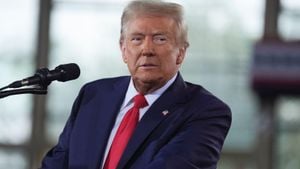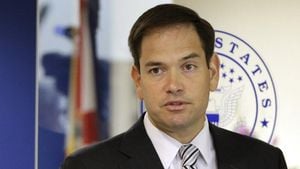Recent protests have erupted across major cities, most prominently at the Museum of Modern Art (MoMA) in New York City and various locations throughout Paris, as activists voice their disapproval of pro-Israel events and organizations supporting Israeli policies amid the continuing conflict involving Palestine.
On November 12, 2024, about forty demonstrators gathered at MoMA's 53rd Street entrance, protesting the World Jewish Congress (WJC) during their Theodor Herzl Award Dinner. The protests were organized by groups advocating for Palestinian rights, including Writers Against the War on Gaza (WAWOG) and Within Our Lifetime. The demonstration was primarily aimed at Ronald Lauder, the Honorary Chair of MoMA and president of the WJC, who has been criticized for his support of Israeli government actions. Protestors chanted slogans such as "Free Palestine" and called upon MoMA to sever its financial ties with organizations they believe promote violence and oppression.
Notably present were key activists like Sarah Nicole Prickett, who was stopped by police for allegedly disorderly conduct, indicating law enforcement's heightened presence at the event. A spokesperson for the New York Police Department confirmed one arrest made during the protests, emphasizing the charged atmosphere surrounding the dinner. Prickett, reflecting on the protest's intentions, stated, "The least we can do is disorder things" and urged institutions to recognize their complicity by not addressing the issues associated with groups like the WJC.
Meanwhile, across the Atlantic, Paris witnessed its own wave of protests against pro-Israel sentiments. Activists mobilized against events perceived as supportive of Israeli policies, particularly those directly related to the Israeli occupation of Palestine. Demonstrators filled the streets, carrying flags and placards denouncing the systematic oppression experienced by Palestinians. Much like the New York protests, those held in Paris were characterized by messages of solidarity with Palestine and calls for justice and accountability.
Both protests highlight the growing discontent manifesting through activism worldwide, particularly against organizations and figures viewed as enablers of state-sponsored violence. Activists argue these institutions have failed to acknowledge or respond to their roles within the larger geopolitical issue. Back at MoMA, the protestors conveyed their discontent through art, facing off against the prestigious institution, which they accuse of abstracting the moral quandaries associated with its benefactors. Many protestors echoed sentiments stressing the moral obligation of cultural institutions to prioritize ethical contributions over financial gains from controversial backers.
Support for the demonstrations arose not only from explicitly pro-Palestinian groups but also from activists focused on broader issues like environmentalism. Liv Senghor, associated with the group Planet Over Profit, stated, "We thought it was important for us to show up as climate protesters to show solidarity and understand all our struggles are connected." Such intersections of activism showcase the potential for solidarity among various social justice movements, emphasizing how issues of oppression reach beyond singular narratives.
The protests have not gone unnoticed by cultural institutions, but reactions have been varied. While some museums like MoMA have faced increasing pressure to reevaluate their ties to controversial figures and organizations, others remain silent. The WJC's Theodor Herzl Award, for example, honored significant figures this year, including U.S. Ambassador to China Jon M. Huntsman Jr., highlighting the tension within the Jewish community itself about how to address this growing divide.
The conflict has exposed rifts not only along political lines but also within broader societal values concerning art, memory, and advocacy. Some artists and cultural figures have openly supported the protests, expressing dismay and disappointment over institutional affiliations with groups accused of minimizing the plight of Palestinians. The silent complicity of museums and art organizations reportedly serves as fertile ground for the protestors who insist on visibility and accountability.
Protestors assert they will continue using visible platforms to demand change, stating it is imperative to let those organizations know they cannot disregard the consequences of their financial affiliations. The artistic and public forums alike may see more actions calling for justice as the debate surrounding Palestine continues to escalate globally. The protests serve as reminders of the significance of art as both commentary and witness to pressing socio-political issues.
Underscoring the urgency of the current wave of protests is the backdrop of widespread calls for accountability, reflecting the interactions among historical grievances, global politics, and cultural representation. These protests mark more than signs of disapproval; they express the long-standing frustrations enveloping the plight of Palestinians, amplifying the need for continued discourse and action surrounding the Israeli-Palestinian conflict, which remains unresolved amid cycles of violence.



